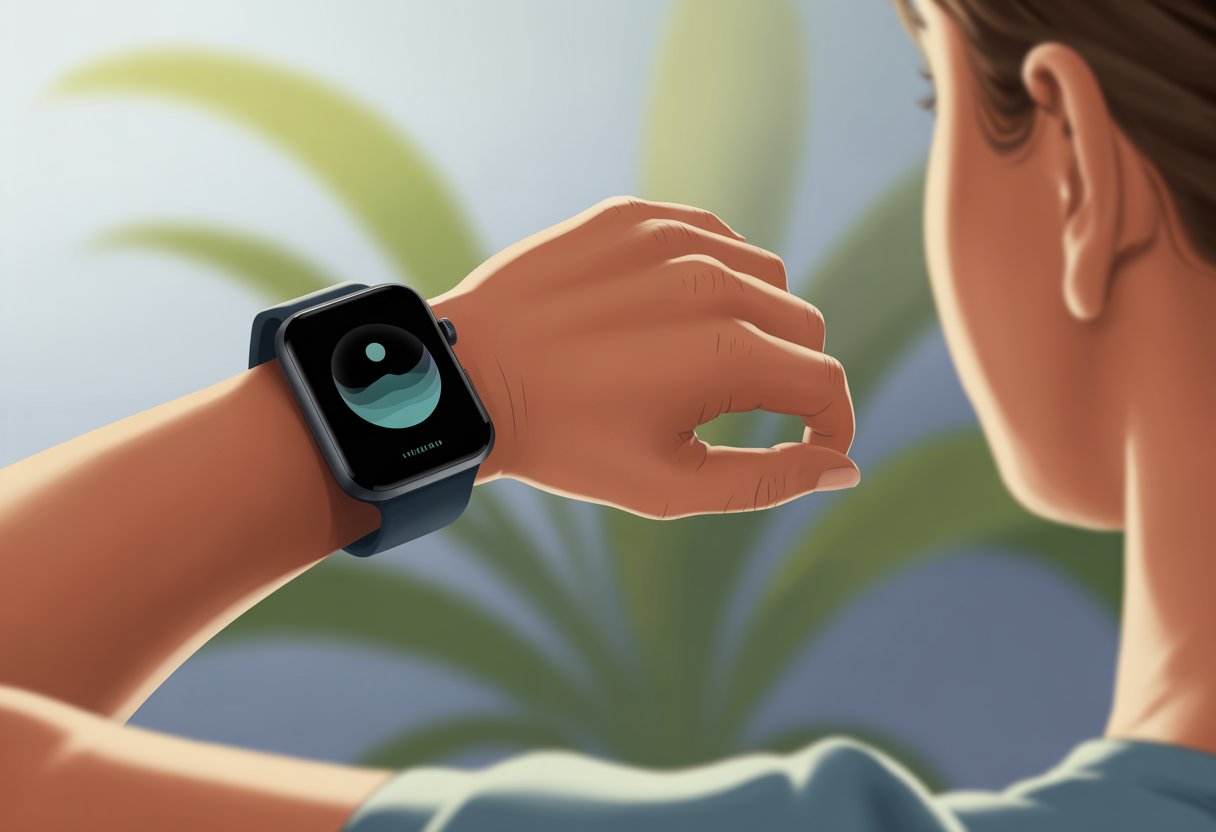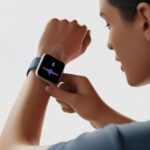Let’s be real—sometimes we all forget to actually breathe, especially when our day feels like an endless parade of notifications and half-finished to-do lists.
Thankfully, our smartwatch has moved on from just counting steps; now it’s ready to help us wrangle our breathing back to something resembling calm. With guided breathing on a smartwatch, we get easy, step-by-step exercises that help us chill out, lower stress, and even drop our heart rate—all with a quick tap.

So the next time we catch ourselves holding our breath (and not because we’re swimming), we can just let our smartwatch nudge us—breathe in, breathe out, maybe even crack a smile. Garmin and Samsung, for example, have built-in breathing activities that lead us through calming routines, making us feel like we totally know what we’re doing—even without a yoga mat.
Guided breathing has never looked so simple or, honestly, so cool.
If you want to see breathing exercises in action, there are quick tutorials out there, like this one for breathing exercises on the Galaxy Watch Ultra.
Let’s just take a breath, trust the tech, and use our smartwatch superpowers for something besides counting steps.
What Is Guided Breathing on a Smartwatch?
Guided breathing on a smartwatch feels like having a chill yoga coach on your wrist, minus the side-eye and with a lot more battery.
We get step-by-step breathing prompts, some health tips, and a little boost for our mindfulness game—all without even lifting a finger.
How Guided Breathing Exercises Work
Most smartwatches guide us through breathing exercises using on-screen cues, gentle vibrations, or calming images.
The watch might tell us to inhale for four seconds, hold, and then exhale in a pattern like “box breathing.” It keeps us focused and stops us from forgetting to breathe or going overboard.
When we do a guided session, the smartwatch tracks our breathing pace and sometimes our heart rate too.
It logs our sessions, so later we can check our progress or just feel good that we took a moment to relax.
Some watches let us tweak the session length or breath duration, so we have a bit of control over how chill we want to get.
Guided breathing isn’t just for meditation fans; it’s for anyone who needs a quick reset.
With reminders, vibrations, and friendly visuals, it’s actually tough to forget to breathe—even when things get hectic.
Benefits for Mindfulness and Stress Management
Breathing exercises on smartwatches aren’t just another feature—they help us pause, lower stress, and maybe even hit our mindfulness goals.
If we stick to guided breathing, we’ll likely notice less tension and a better mood. Sometimes, it’s surprising how quickly that happens.
For anyone who can’t sit still, guided breathing is a fast track to calm.
Our heart rate can drop, focus sharpens, and suddenly our to-do list feels less scary.
We might even sleep better or dodge those stress headaches.
A few science-backed perks:
- Lower stress levels
- Better focus and mindfulness
- Support for healthy blood pressure
- Easier relaxation during busy days
And honestly, seeing our progress tracked feels great.
Popular Smartwatch Brands That Offer Guided Breathing
Guided breathing isn’t just for one brand.
Some of the biggest names, like the Apple Watch, have guided breathing apps built right in.
These apps are straightforward and just a tap away.
If you’re on team Android, don’t stress.
Wear OS watches offer guided breathing too, with reminders so we don’t totally forget.
Samsung and Garmin have their own takes on breathing exercises and mindfulness routines.
Quick comparison:
| Brand | Guided Breathing Feature | OS Support |
|---|---|---|
| Apple Watch | Breathe app | iOS |
| Samsung/Galaxy | Breathing exercises app | Android/Wear OS |
| Garmin | Breathwork activity profile | iOS, Android |
| Wear OS | Built-in or third-party options | Android |
So, whether we’re Apple fans, Android loyalists, or Garmin enthusiasts, there’s a guided breathing option waiting for us.
We just have to remember to use it.
Setting Up Guided Breathing on Your Smartwatch
Before we start channeling our inner zen master, let’s make sure our smartwatch is good to go.
A few quick tweaks and we’ll be breathing easy—and maybe even impressing the cat with how relaxed we look.
Finding the Guided Breathing Feature
Let’s be honest, our smartwatch sometimes hides features better than we hide snacks.
First step: find the guided breathing app.
On an Apple Watch, we just tap the Breathe app—though let’s admit, not all of us use it as much as we claim.
Fitbit users can spot “Relax” or “Guided Breathing” in the main list.
For Wear OS (like Google Pixel Watch or Samsung Galaxy Watch), swipe through the app menu or check the “Fit” section for mindfulness.
It’s usually easier than finding a matching pair of socks.
Some watches let us add the breathing shortcut to our main watch face, so it’s always just a tap away.
No more excuses for skipping that pre-meeting breathing break.
Need more help? Check out Apple’s guide about Breathe sessions.
Connecting to Health and Fitness Apps
After we find the breathing feature, it’s time to sync up our health data.
Apps like Google Fit, Apple Health, or Samsung Health play nice with most smartwatches and track our breathing history.
Syncing usually means opening the companion app on our phone, logging in, linking accounts, and making sure Bluetooth isn’t being stubborn.
Some devices sync automatically; others need a nudge.
If we get it right, every deep breath gets logged—kind of satisfying, honestly.
Understanding Compatibility With Devices
Not all smartwatches play by the same rules.
Apple Watch works best with iPhone, while Fitbit, Wear OS, and others usually support both Android and iOS.
If we want to pair with health apps, look for Google Fit, Apple Health, or similar programs.
Make sure our watch supports the latest Bluetooth, so syncing doesn’t turn into a tech headache.
Some features—like guided breathing—might not work on older models or might need a software update, so it’s worth checking for updates first.
Quick table for reference:
| Smartwatch Type | Works Best With | Guided Breathing Name | App Sync |
|---|---|---|---|
| Apple Watch | iPhone | Breathe | Apple Health |
| Fitbit | Android/iOS | Relax | Fitbit App |
| Wear OS | Android/iOS | Breathing/Relax | Google Fit |
If all else fails, we can always just breathe the old-fashioned way—but where’s the fun in that?
How to Use Guided Breathing Exercises
Using guided breathing on a smartwatch is actually simple once we get the hang of it.
Let’s break it down into steps, from starting a session to tracking our progress.
Starting a Guided Session
First up, find the guided breathing exercise on your smartwatch.
Most watches have a “Breathing” or “Relax” app right there on the screen.
Garmin and Fitbit usually ask us to sit down, get comfy, and wear the watch snugly above the wrist bone.
We’re aiming for relaxation here, so it helps to find a quiet spot with minimal interruptions.
Once we select the session, the watch often lets us pick how long we want to breathe—maybe 2 minutes, maybe 15.
If your watch is fancy, you might get to choose different breathing styles, like “Box Breathing” or “Coherence.”
If not, no worries—the basic guided session works just fine.
Following the Breathing Prompts
Now for the main event—doing what the smartwatch says.
When we start, the display shows prompts, sometimes with calming animations or gentle vibrations.
We’ll see instructions for when to inhale, hold, and exhale.
For example, Garmin suggests inhaling for 4 seconds, holding for 7, and exhaling for 8.
Other watches keep it simple with an even rhythm, like 4 seconds each step.
The watch keeps us on track, so no need to stare at a clock.
If we zone out or start thinking about lunch, the watch’s little nudges bring us back.
Just follow the display and breathe along.
Tracking Progress and Duration
After our breathing session, the smartwatch shows off our stats.
We might see how long we practiced, whether our rhythm stayed steady, and sometimes even get a snapshot of our heart rate or relaxation score.
Some watches, like Garmin, log all our sessions so we can set reminders, check our history, and maybe compete with ourselves for “Chillest Person of the Week.”
If only there was an actual trophy for that.
Thanks to these features, sticking with guided breathing exercises is easy—and, honestly, a little addictive.
Measuring Health Benefits With Your Smartwatch
Smartwatches let us keep an eye on key health numbers right from our wrists.
They show us real-time changes in heart rate, blood oxygen, and heart rate variability, so we don’t have to guess if we’re okay.
Understanding Heart Rate Monitoring
With heart rate monitoring, we get to watch our hearts in action—no stethoscope required. Our smartwatches keep tabs on every beat, whether we’re jogging, napping, or just debating another slice of cake.
Most models show live heart rate data, flagging spikes or sudden drops, and even buzzing us if something’s weird. Some watches also track resting heart rate, so we can actually see how chill (or not) we are all day.
When we spot patterns, it’s easier to tell if we’re getting enough exercise or just spending too much time on the couch. For extra peace of mind, certain watches detect irregular rhythms, so we don’t miss any surprises from our hearts.
There’s more about that at heart rate monitoring for smartwatches.
Tracking Oxygen Levels and Heart Rate Variability
Let’s talk about oxygen—because honestly, who doesn’t want to breathe easy? Lots of smartwatches now check our blood oxygen levels, showing how much O2 is floating around in our bodies.
If our oxygen dips too low, the watch lets us know, so we’re not left wondering why we feel wiped out. Then there’s heart rate variability (HRV), which measures those tiny changes between heartbeats.
A higher HRV usually means we’re handling stress pretty well. If it drops, maybe it’s time to slow down, grab some water, or skip that fifth coffee.
Everyone’s healthy range is a bit different, but tracking these numbers helps us catch changes early. If you’re curious, here’s more about tracking oxygen levels and HRV with a smartwatch.
Integrating Breathing Sessions With Other Fitness Features
A smartwatch isn’t just a wrist computer for counting steps or checking texts. It can guide us through breathing exercises and work with our fitness goals to help us feel stronger and less stressed.
Linking to Meditation and Wellness Goals
Our smartwatches can make meditation and wellness feel like less of a chore and more like a daily team-up. Some wearables let us schedule breathing exercises right alongside meditation sessions, so we get reminders to actually pause and take a breath.
When we use guided breathing tools, the watch tracks our lower stress levels and adds that progress to our wellness stats. It’s almost like getting an A+ for sitting still and breathing.
Many smartwatches, like some Garmin models, offer personalized guidance to fit different goals. They help us improve mindfulness, balance, and focus—no tie-dye shirts or gongs required.
Some apps let us set wellness goals, like practicing mindful breathing three times a week or boosting our calmness score before the month ends. We might not be monks, but our smartwatch definitely cheers us on. For more on how wearables help with meditation, check out how meditation and wellness apps integrate with fitness tracking.
Combining With Activity Tracking and Workouts
Breathing exercises don’t have to live in their own bubble—they can totally team up with our workouts and activity tracking. A quick breathing session after cardio slows our heart rate and can speed up recovery.
Some smartwatches let us log breathing right next to strength training or running. The device might even suggest a calming routine after a tough workout, based on our heart rate or stress data.
Sometimes, it nudges us to breathe on purpose, not just because we’re out of breath from burpees. Here’s a quick list of how breathing sessions team up with activity tracking:
- Lowering heart rate after exercise
- Reducing post-workout stress
- Tracking breathing stats with fitness trends
- Reminding us to breathe during tough workouts
Want to see this in action? Garmin watches have a breathwork activity profile that links guided breathing with workout and activity data—no Jedi skills required.
Maximizing Daily Wellness With Smartwatch Breathing Tools
Life gets busy, and sometimes we need a little help to keep our bodies and minds balanced. Our smartwatches can do a lot more than just buzz when Aunt Linda sends another cat meme.
Improving Sleep Quality and Patterns
Let’s be honest—naps are great, but real sleep is where it’s at. By using guided breathing tools on our smartwatches, we can slow down before bed and make it easier to fall asleep.
Some devices help us wind down with custom breathing sessions—kind of like bedtime stories, but for our lungs. After we use these tools, our watches track sleep patterns through the night, showing us the light and deep stages, the wild midnight tosses, and even how long we snore.
When we look at our sleep data, we can see how relaxing routines affect our rest. Making guided breathing a nightly habit sets us up to wake up less grumpy and more alert, with the stats to back it up.
Read more about features for maximizing wellness with smartwatches.
Supporting Cardiovascular Health
Our hearts might skip a beat when pizza arrives, but steady beats are what we need for health. Smartwatch breathing tools guide us through slow, deep breaths that calm our nerves and help lower short-term heart rate spikes.
Many watches have stress alerts. If our heart rate jumps because of a surprise math quiz or public speaking, the device prompts us to pause and breathe.
While it won’t turn us into math geniuses, our blood pressure and stress levels might thank us. Over time, regular breathing sessions combined with heart tracking help us spot healthy trends—or warning signs—early.
A few minutes a day might not turn us into superheroes, but it definitely makes taking care of our hearts easier. Check out how breathing exercises lower stress and support heart health on this smartwatch health features guide.
Troubleshooting Guided Breathing on Smartwatches
Ever stare at your smartwatch, hoping for calm, but just get more stressed? Let’s roll up our sleeves and fix the annoying stuff that makes guided breathing less “zen” and more “zen-where’d-it-go?”
We’ll tackle the glitches and keep our batteries from giving up during meditation.
Resolving Common Issues
If our guided breathing app just won’t cooperate, it’s usually one of two things: a software hiccup or user error (hey, we’ve all tapped the wrong button). Common issues are the display freezing, random session stops, or the watch not reading our heart rate.
A quick reboot usually does the trick. If the screen freezes, hold down the power button until it restarts.
Still stuck? Double-check if the firmware is up to date. Updates often bring important fixes.
Sometimes, the sensor won’t read our breath or heart rate. Make sure the watch is snug, but not cutting off circulation. Sweat or lotions can mess with sensors, so a quick wipe helps.
If nothing works, there’s usually a step-by-step reset guide on the official support pages for Garmin and Polar Serene.
Managing Battery Life While Using Breathing Features
Guided breathing may relax us, but our smartwatch needs a break too. Long sessions, bright screens, and always-on sensors can drain the battery faster than we’d like.
The best move? Tweak a few settings before we get too zen. Lower the display brightness—our breathing doesn’t need a light show.
Turning off unnecessary notifications during sessions keeps the only buzz coming from our inner peace. If possible, use battery saver or “Do Not Disturb” mode while running guided breathing.
To help the battery last, keep sessions short. Try not to stack guided breathing exercises back-to-back, unless you’re training for Olympic-level relaxation.
Regular charging habits help, too. Charging while showering or brushing our teeth usually gives us enough juice for both health and harmony.
Comparing Guided Breathing Across Smartwatch Platforms
Not all smartwatches handle guided breathing the same way. Features, compatibility, and even that zen feeling depend on whether we’re team Apple, team Android, or somewhere in between.
Key Differences: Apple Watch, Wear OS, and Others
Let’s be real—guided breathing isn’t just for yoga fans. On the Apple Watch, the Breathe app offers visuals, gentle taps, and tracks how long we chill out.
We get timers, daily reminders, and those pretty circles that shrink and grow to keep us on pace. Wear OS watches, powered by Google, offer similar breathing exercises, but with some twists.
Instead of “Breathe,” we get Google Fit’s “Mindful Minute” or other third-party apps. They’re flexible but can feel a bit more basic. We still get vibrations and on-screen prompts, but the layout feels more utilitarian.
Other smartwatch brands add their own spin. Some use expanding and contracting circles to guide our breaths, and others add sounds or voice prompts.
According to reviews, models like the WalkerFit M6 Ultra use visual cues, making it easier to manage stress and follow along with guided breathing sessions.
Health Data, Integration, and App Compatibility
Here’s where things get interesting—and honestly, a bit competitive. Apple Watch keeps our health data tucked away in the Health app. Every breath, every calm session, and every heart point ends up tracked right alongside calories burned (if we’re counting).
It works smoothly with iOS-based health apps and syncs up fast. Wear OS watches play nice with Android and, sometimes, even iOS.
Google Fit manages things like stress tracking, breathing sessions, and Heart Points. This setup lets us share data between devices and apps—team Android, anyone?
Switching between apps doesn’t take much effort if we’re okay with a bit of setup. Other smartwatches? They definitely have their quirks.
Some platforms guard our breathing history and don’t want to share. Others do their best to sync with both Android and iOS health apps.
If cross-compatibility matters to us, it’s worth checking which wearables actually work well with Google Fit and third-party health apps before we jump in. You might want to take a look at this breakdown if you’re curious.
- Why do my Bluetooth headphones keep resetting? Solving the Mystery of Rebooting Ears - January 5, 2026
- Is WHOOP Worth It for Runners, Cyclists, and Weightlifters or Just Another Expensive Wrist Buddy? - January 5, 2026
- Best Fitness Trackers Under $200 That Won’t Make Your Wallet Sweat - January 4, 2026






